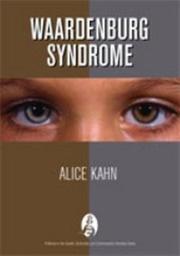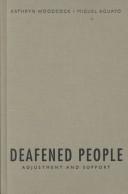| Listing 1 - 10 of 245 | << page >> |
Sort by
|
Book
Year: 2021 Publisher: London : IntechOpen,
Abstract | Keywords | Export | Availability | Bookmark
 Loading...
Loading...Choose an application
- Reference Manager
- EndNote
- RefWorks (Direct export to RefWorks)
The auditory system is one of the finest structures in the human body. Although its anatomical structure is so small compared to other organs, without it, it would greatly affect a person's basic life. Hearing loss, also known as hearing impairment, is a partial or total inability to hear. When people communicate with others, listening is always the first step. That is why Helen Keller once said, "Blindness separates people from things; deafness separates people from people." To avoid the "epidemic" of hearing loss in the near future, it is necessary to promote early screening, change public attitudes toward noise, and wear hearing aids appropriately. Based on the contributions of many authors, whom I sincerely respect, this book incorporates updated developments as well as future perspectives in the ever-expanding field of hearing loss. This book can also serve as a reference for persons who are involved in this field whether they are clinicians, researchers, or patients.

ISBN: 1597567620 9781597567626 1597560219 9781597560214 Year: 2007 Publisher: San Diego : Plural Publishing,
Abstract | Keywords | Export | Availability | Bookmark
 Loading...
Loading...Choose an application
- Reference Manager
- EndNote
- RefWorks (Direct export to RefWorks)
This book intends to provide information about Waardenburg syndrome, covering basic genetic concepts, and continuing with specific information about the four types of Waardenburg Syndrome as well as providing practical guidance on recognizing individuals with the syndrome, testing for hearing loss, and parent and patient counseling.
Book
Year: 2020 Publisher: London, England : IntechOpen,
Abstract | Keywords | Export | Availability | Bookmark
 Loading...
Loading...Choose an application
- Reference Manager
- EndNote
- RefWorks (Direct export to RefWorks)
This book covers some innovative aspects of the multifaceted and continuously evolving field of rehabilitation of hearing loss. International leading experts share their view and advanced experience on unilateral deafness, services for the hard of hearing, hair cell regeneration, advanced imaging, active middle ear and bone conduction hearing aids, and cochlear implants.
Book
Year: 2017 Publisher: London, United Kingdom : Academic Press/an imprint of Elsevier,
Abstract | Keywords | Export | Availability | Bookmark
 Loading...
Loading...Choose an application
- Reference Manager
- EndNote
- RefWorks (Direct export to RefWorks)
"Hearing Loss: Causes, Prevention, and Treatment covers hearing loss, causes and prevention, treatments, and future directions in the field, also looking at the cognitive problems that can develop. To avoid the "silent epidemic" of hearing loss, it is necessary to promote early screening, use hearing protection, and change public attitudes toward noise. Successful treatments of hearing loss deal with restoring hearing sensitivity via hearing aids, including cochlear, brainstem, or midbrain implants. Both the technical aspects and effects on the quality of life of these devices are discussed. The integration of all aspects of hearing, hearing loss, prevention, and treatment make this a perfect one-volume course in audiology at the graduate student level. However, it is also a great reference for established audiologists, ear surgeons, neurologists, and pediatric and geriatric professionals"--Publisher's description.
Deafness. --- Neoplasms --- Hearing disorders. --- Deafness --- Hearing disorders --- Prevention. --- Treatment.
Book
ISBN: 3031384954 Year: 2023 Publisher: Cham : Springer International Publishing : Imprint: Springer,
Abstract | Keywords | Export | Availability | Bookmark
 Loading...
Loading...Choose an application
- Reference Manager
- EndNote
- RefWorks (Direct export to RefWorks)
This book provides a broader understanding of infectious diseases and hearing loss prevention and treatment in children. In addition to all the common infections, the book covers the prion diseases, the autoinflammatory syndromes, and diseases of unknown etiology. A specific chapter is dedicated to cochlear implant infections. The final part reviews the available therapeutic agents. Written by international experts, the book will appeal to a wide readership, from ENT and pediatrics trainees, to practitioners and researchers in these disciplines.
Otorhinolaryngology. --- Pediatrics. --- Deafness in children.
Book
ISBN: 1635502748 Year: 2017 Publisher: San Diego : Plural Publishing, Incorporated,
Abstract | Keywords | Export | Availability | Bookmark
 Loading...
Loading...Choose an application
- Reference Manager
- EndNote
- RefWorks (Direct export to RefWorks)
"Cochlear Implants: Audiologic Management and Considerations for Implantable Hearing Devices provides comprehensive coverage of the audiological principles and practices pertaining to cochlear implants and other implantable hearing technologies. This is the first and only book that is written specifically for audiologists and that exhaustively addresses the details involved with the assessment and management of cochlear implant technology. Additionally, this book provides a through overview of hybrid cochlear implants, implantable bone conduction hearing technology, middle ear implantable devices, and auditory brainstem implants."--Publisher's description.
Book
ISBN: 1597566462 9781597566469 9781597565073 1597565075 Year: 2014 Publisher: San Diego, California : Plural Publishing,
Abstract | Keywords | Export | Availability | Bookmark
 Loading...
Loading...Choose an application
- Reference Manager
- EndNote
- RefWorks (Direct export to RefWorks)
As a guide to performing stapedectomies, this book is a concise and practical aid paired with an invaluable atlas developed by internationally acknowledged experts. The 15 videos included demonstrate a step-by-step approach to performing stapedectomy procedures. The young surgeon studying stapes surgeries will find these videos applicable to challenges specific to this surgery, and seasoned surgeons will find these videos to be a convenient resource.
Otosclerosis. --- Otospongiosis --- Deafness --- Labyrinth (Ear) --- Diseases
Book
Year: 2022 Publisher: Cape Town, South Africa : AOSIS,
Abstract | Keywords | Export | Availability | Bookmark
 Loading...
Loading...Choose an application
- Reference Manager
- EndNote
- RefWorks (Direct export to RefWorks)
Within the well-documented understanding of occupational noise-induced hearing loss (ONIHL) being a complex occupational health condition requiring the adoption of the complex interventions approach to management, challenges confronting hearing conservation programs (HCPs) within the African context need clear characterization and insightful deliberation. Guided by the systems theory, to be realistic about the implementation, monitoring, as well as evaluation of outcomes of HCPs within the African mining context, this book is a call for a paradigm shift in the assessment and management of ONIHL and HCPs in African mines . This book, Occupational Noise Induced Hearing Loss: An African Perspective, Teams researchers involved in the management of ONIHL and implementation of HCPs with evidence that allows for contextually relevant best practices in mine settings, particularly those located in low-and-middle-income countries (LMICs). This best practice is multidisciplinary in nature and engages all stakeholders in all relevant sectors, with the goal of adopting a preventive audiology approach to ONIHL rather than the compensation-oriented approach that is currently prevailing. This book is a research-driven contribution to the occupational health and safety (OHS) space, with ONIHL as a focus case study, and it provides contemporary, contextually relevant, and responsive evidence related to ONIHL and HCPs in LMICs with a very specific focus. in the South African context. This book expansively addresses all aspects of ONIHL and HCPs in one volume, with careful considerations of complexities and challenges to HCPs implementation, applicable specifically to LMICs, although useful globally. The book offers potential solutions and recommendations for all challenges identified, having carefully and deliberately engaged with local evidence, local context, and local policies and regulations to ensure an Afrocentric contribution to the world of evidence.
Industrial safety. --- Deafness, Noise induced. --- Occupational diseases.

ISBN: 1442673745 1281995940 9786611995942 9781442673748 9781281995940 0802048455 9780802048455 0802083730 9780802083739 Year: 2000 Publisher: Toronto, [Ontario] ; Buffalo, [New York] ; London, [England] : University of Toronto Press,
Abstract | Keywords | Export | Availability | Bookmark
 Loading...
Loading...Choose an application
- Reference Manager
- EndNote
- RefWorks (Direct export to RefWorks)
It is estimated that there are currently 1.9 million deafened people living in North America - individuals who could once hear naturally or with amplification but have become deaf and are now unable to rely on hearing to comprehend spoken information. Despite this vast number, until now there have been few books that specifically address the process of adjustment to, and acceptance of, deafness as an adult. Kathryn Woodcock and Miguel Aguayo have addressed that situation with their unique look at deafness in Deafened People: Adjustment and Support. The authors demonstrate that deafness is not merely a medical condition; it is a social disability that affects the individual, the family, the social circle, and the work group. By describing the psychosocial experience of acquired deafness as a process of adjustment, Woodcock and Aguayo demonstrate that acceptance of deafness is a process involving practical, social, and emotional implications. To assist in that process, the authors have provided a guide to self-help techniques of proven value to deafened people. Drawing on their own experiences as deaf professionals, Woodcock and Aguayo explore such questions as how deafness occurs, how relationships (professional and personal) can be affected by progressive deafness, and how and where to find peer support. Section 1 describes the process of adjustment, while section 2 offers a practical guide to a successful method of establishing a self-help support network, with reference to such organizations as the Association of Late-Deafened Adults. Written in a lively, engaging style, the book combines medical background, professional advice, information on resources, and personal examples. Deafened People: Adjustment and Support will be invaluable for medical professionals and lay readers alike.
Deaf --- Postlingual deafness. --- Self-help techniques. --- Self-change techniques --- Self-directed change --- Life skills --- Psychology, Applied --- Acquired deafness, Postlingually --- Postlingually acquired deafness --- Deafness --- Deaf services --- Services for. --- Deaf people
Book
ISBN: 1283856786 1614510458 9781614510451 1614510431 9781614510437 9781283856782 Year: 2012 Volume: 47 Publisher: Berlin ; Boston : De Gruyter,
Abstract | Keywords | Export | Availability | Bookmark
 Loading...
Loading...Choose an application
- Reference Manager
- EndNote
- RefWorks (Direct export to RefWorks)
This is the first comprehensive account of prolonged hearing loss and its impact on a language that was once spoken fluently. Although it is currently assumed that hearing loss results in speech deterioration, it is shown that language loss occurs when speakers remain deaf for a long time. The reader is introduced to a significant deaf population - postlingually deafened Yoruba speakers who have been deaf for more than twenty years and who have no access to hearing aids or speech therapy. After becoming deaf, they continue to speak Yoruba from memory and "hear" visually through lip reading. These speakers exhibit phonological, lexical and syntactic losses which mirror acquisition patterns attested in the speech of Yoruba children. Based on these similarities, it is argued that a direct link exists between language loss and first language acquisition. It is further argued that prolonged deafness results in language reversal. Finally, the book presents the first description of the sign language and gestures used by deafened speakers to augment their spoken language. These findings will be of value to linguists, speech, language and hearing therapists, anthropologists, Africanists, deaf studies researchers, and non-specialists who are interested in hearing health and wellness.
Postlingual deafness --- Yoruba language --- Acquired deafness, Postlingually --- Postlingually acquired deafness --- Deafness --- Aku language --- Eyo language --- Nago language --- Yariba language --- Kwa languages --- Patients --- Rehabilitation --- Phonology. --- Deaf Communities. --- Language Acquisition. --- Language Attrition. --- Sign Languages. --- Yoruba.
| Listing 1 - 10 of 245 | << page >> |
Sort by
|

 Search
Search Feedback
Feedback About UniCat
About UniCat  Help
Help News
News